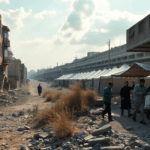Table of Contents
The relationship between the United States and Iran has been anything but smooth for decades, and recent events have only cranked up the tension. With the launch of US military operations known as ‘Operation Midnight Hammer’, many are left wondering what this means for the future of US-Iran relations and the ripple effects across the Middle East.
So, what’s really going on beneath the surface of this complicated conflict? Let’s dive in.
Overview of the conflict and recent developments
In the past few weeks, the geopolitical landscape has taken a dramatic turn following a series of US strikes aimed at crippling Iran’s nuclear ambitions.
These military actions are being portrayed as a direct response to Iran’s ongoing development of its nuclear program, which the US government claims poses a credible threat to both regional and international security. The Pentagon has described these strikes as having ‘devastated’ Iran’s nuclear capabilities, further raising the stakes in an already volatile situation.
But it’s not just about military strategy; the political implications back in the US are also significant. Lawmakers have questioned the constitutionality of these military actions, with many criticizing the Trump administration for taking such aggressive steps without seeking congressional approval.
This has sparked a wider debate on the limits of executive power when it comes to national security, highlighting a growing divide in American politics over foreign intervention and military involvement.
And what about public sentiment? Anti-US feelings are running high in Iran and beyond, evidenced by large-scale protests led by Iranian leaders and pro-Palestinian activists in cities like New York.
This public outcry doesn’t just reflect anger toward US policies; it also points to the potential for increased unrest both within Iran and among its allied nations in the region.
Responses from Iran and global implications
In response to the US strikes, Iran’s leaders have promised to retaliate decisively.
What might this look like? It could range from cyber-attacks on US interests to boosting support for proxy groups throughout the Middle East. Analysts warn that such actions could further destabilize the region, creating a cycle of retaliation that may pull neighboring countries into the fray.
The international community is keeping a close watch on this situation. Nations that traditionally support Iran, like Russia and China, have condemned the US actions and called for restraint and dialogue. The potential for a broader conflict involving multiple countries sends alarm bells ringing for global security, especially in a world already fraught with competing interests in oil, trade, and military alliances.
Moreover, these recent events could have lasting impacts on global oil markets. The fear of disruptions in the Strait of Hormuz—one of the world’s most crucial shipping lanes—could lead to price hikes and supply shortages. Both investors and governments are monitoring developments closely, as the economic consequences could be significant.
Future outlook and potential scenarios
As we look to the future, the path of US-Iran relations remains shrouded in uncertainty. Several scenarios could unfold, depending on how both sides choose to respond. On one hand, there’s the possibility of renewed diplomacy, with both parties recognizing the mutual benefits of de-escalation. But let’s be real—the chances of ongoing hostilities are also quite high, especially if Iran views the US strikes as an existential threat.
Then there’s the domestic political scene in the US, which will undoubtedly influence future actions. With elections on the horizon, candidates may use foreign policy as a hot-button issue, adding yet another layer of complexity to the situation. Voter opinions on military interventions are likely to shape the administration’s approach, potentially swinging from aggressive tactics to a more conciliatory stance.
In conclusion, the recent US strikes on Iran represent a pivotal moment in Middle Eastern geopolitics. The interplay of military actions, public sentiment, and international diplomacy will not only determine the fate of US-Iran relations but will also impact the broader stability of the region. As this situation continues to unfold, it’s vital for stakeholders and observers to remain vigilant, recognizing the intricate web of factors at play.





